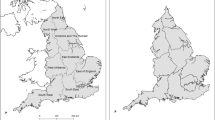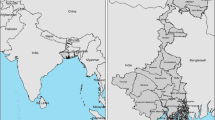Abstract
This paper presents a spatial analysis of multiple deprivation in South Africa and demonstrates that the most deprived areas in the country are located in the rural former homeland areas. The analysis is undertaken using the datazone level South African Index of Multiple Deprivation which was constructed from the 2001 Census. Datazones are a new statistical geography designed especially for this Index using techniques developed in the United Kingdom. They are smaller in population size than wards, enabling fine-grained spatial analysis of deprivation across the whole of South Africa. The spatial scale used is the smallest to be used in a developing country to date. Levels of deprivation are compared between former homeland areas as a whole, the rest of South Africa and a case-study township, as well as between each former homeland. Individual dimensions of deprivation and an overall composite measure are presented. Municipality-level analysis shows that this spatial pattern of multiple deprivation continued to persist in 2007, demonstrating the ongoing spatial legacy of apartheid.




Similar content being viewed by others
Notes
As will be explained below, the analysis makes use of the full (or ‘100%’) version of the Census.
The datazones are described in more detail below. Their average population size is 1,962 people.
The non institutional population comprises the population that did not spend the Census night in an institution e.g. prisons, hospitals, army barracks or a tourist hotel.
Magisterial districts—of which there are 354—are a subdivision of provinces created for the justice system and relate to the location of magisterial offices.
Municipalities are the area of jurisdiction of the third sphere of government, after the national and provincial levels. There are six metropolitan municipalities. Non-metropolitan areas are divided into 47 district municipalities which contain 231 local municipalities and 25 district management areas which are mainly deserts or conservation areas with low residential populations.
These aggregate counts are non-disclosive as individuals cannot be identified at this spatial level.
This technique involves moving unreliable datazone scores (i.e. those with large standard errors) towards another more robust score, in this instance the municipality mean. For further details see Noble et al. (2001b).
This is not the case for the Health Domain as it is expressed at datazone level as Years of Potential Life lost and the former homeland averages are not calculable from the data available.
References
Afrobarometer (2004). Lived poverty in South Africa: Desperation, hope and patience. Afrobarometer Briefing Paper No. 11. Cape Town: Afrobarometer.
Afrobarometer (2005). Lived poverty in South Africa. Afrobarometer Briefing Paper No. 13. Cape Town: Afrobarometer.
Aliber, M., de Swardt, C., du Toit, A., Mbhele, T., & Mthethwa, T. (2005). Trends and policy challenges in the rural economy—four provincial case studies. Cape Town: HSRC Press.
Alkire, S., & Santos, M. E. (2010). Acute multidimensional poverty: A new index for developing countries. OPHI Working Paper No. 38. Oxford: Oxford Poverty and Human Development Initiative, University of Oxford.
Avenell, D., Noble, M., & Wright, G. (2009). South African datazones: A technical report about the development of a new statistical geography for the analysis of deprivation in South Africa at a small area level. CASASP Working Paper No. 8. Oxford: Centre for the Analysis of South African Social Policy, University of Oxford.
Beinart, W. (2001). Twentieth-century South Africa. Oxford: Oxford University Press.
Carter, M., & May, J. (1999). Poverty, livelihood and class in rural South Africa. World Development, 27(1), 1–20.
Chabane, C. (2010). Statement by the minister for performance monitoring and evaluation as well as administration, Collins Chabane, to announce the performance outcomes and measurable outputs. 12th February, Imbizo Media Centre, Cape Town. Available at http://www.thepresidency.gov.za/pebble.asp?relid=1951. Accessed 05/08/2011.
Christopher, A. J. (1994). The atlas of apartheid. London: Routledge.
Collinson, M., Kok, P., & Ganenne, M. (2006). Migration and changing settlement patterns: Multilevel data for policy. Report 03-04-01. Pretoria: Statistics South Africa.
Day, C., Barron, P., Monticelli, F., & Sello, E. (Eds.). (2009). The district health barometer 2007/08. Durban: Health Systems Trust.
Department of Health, Social Services of the Western Cape. (1999). Poverty in the Western Cape: An analysis of poverty in the Western Cape as enumerated in the 1996 census. Cape Town: Department of Health and Social Services of the Western Cape.
Department of Rural Development, Land Reform. (2010). Comprehensive rural development programme. Republic of South Africa: Department of Rural Development and Land Reform.
Department of Rural Development and Land Reform (2010b). Annual Report 1 April 2009–31 March 2010. Republic of South Africa: Department of Rural Development and Land Reform.
Department of Rural Development and Land Reform (2011). http://www.ruraldevelopment.gov.za/DLA-Internet/content/pages/About_Us_The_Department.jsp. Accessed 22/09/11.
Department of the Premier of the Western Cape. (2005). Measuring the state of development in the province of the Western Cape. Cape Town: Department of the Premier, Provincial Government of the Western Cape.
Flowerdew, R., Graham, E., & Feng, Z. (2004). The production of an updated set of data zones to incorporate 2001 census geography and data. Report to the Scottish Executive. School of Geography and Geosciences, Scotland: University of St Andrews.
Greenberg, S. (2010). Status report on land and agricultural policy in South Africa, 2010. Research Report No. 40. Belleville: Institute for Poverty, Land and Agrarian Studies, University of the Western Cape.
Hirschowitz, R. (Ed.). (2000). Measuring poverty in South Africa. Pretoria: Statistics South Africa.
Klasen, S. (1997). Poverty and inequality in South Africa: An analysis of the 1993 SALDRU survey. Social Indicators Research, 41, 51–94.
Klasen, S. (2000). Measuring poverty and deprivation in South Africa. Review of Income and Wealth, 46(1), 33–58.
Lahiff. E. (1997). Land, water and local governance in South Africa: A case study of the Mutale River Valley. Working Paper 7, Rural Resources and Rural Livelihoods Working Paper Series.
Leibbrandt, M., Woodard, C., & Woodard, I. (2000). The contribution of income components to income inequality in the rural former homelands of South Africa: A decomposable gini analysis. Journal of African Economies, 9(1), 79–99.
Leibbrandt, M., Woolard, I., Finn, A., & Argent, J. (2010). Trends in South African income distribution and poverty since the fall of apartheid. OECD Social, Employment and Migration Working Paper No. 101, Paris: OECD Directorate for Employment, Labour and Social Affairs.
Makgetla, N. S. (2010). Synthesis paper: South Africa. South Africa: Development Bank of Southern Africa.
Martin, D. (2002). Geography for the 2001 census in England and Wales. Population Trends, 108, 7–15.
Martin, D., Nolan, A., & Tranmer, N. (2001). The application of zone-design methodology in the 2001 UK census. Environment and Planning, 33, 1949–1962.
Mattes, R., Bratton, M., & Davids, Y. D. (2003). Poverty, survival and democracy in Southern Africa. Afrobarometer Paper No. 23, Cape Town: Afrobarometer.
McIntyre, D., Muirhead, D., & Gilson, L. (2002). Geographic patterns of deprivation in South Africa: Informing health equity analyses and public resource allocation strategies. Health Policy and Planning, 17(1), 30–39.
McIntyre, D., Muirhead, D., Gilson, L., Govender, V., Mbatsha, S., Goudge, J., Wadee, H., & Ntutela, P. (2000). Geographic patterns of deprivation and health inequities in South Africa: Informing public resource allocation strategies. University of Cape Town, University of the Witwatersrand, London School of Hygiene and Tropical Medicine, and National Department of Health.
McLennan, D., Barnes, H., Noble, M., Davies, J., Garratt, E., & Dibben, C. (2011). The English indices of deprivation 2010. London: Department for Communities and Local Government.
Noble, M., Babita, M., Barnes, H., Dibben, C., Magasela, W., Noble, S., et al. (2006a). The provincial indices of multiple deprivation for South Africa 2001. Oxford: University of Oxford.
Noble, M., Babita, M., Barnes, H., Dibben, C., Magasela, W., Noble, S., Ntshongwana, P., Phillips, H., Rama, S., Roberts, B., Wright, G., & Zungu, S. (2006b). The provincial indices of multiple deprivation for South Africa 2001: Technical Report. Oxford: University of Oxford.
Noble, M., Barnes, H., Wright, G., McLennan, D., Avenell, D., Whitworth, A., et al. (2009). The South African Index of multiple deprivation 2001 at datazone level. Pretoria: Department of Social Development.
Noble, M., Barnes, H., Wright, G., & Roberts, B. (2010). Small area indices of multiple deprivation in South Africa. Social Indicators Research, 95(2), 281–297.
Noble, M., Lloyd, M., Wright, G., Dibben, C., & Smith, G. A. N. (2001a). Developing deprivation measures for Northern Ireland. Journal of the Statistical and Social Inquiry Society of Ireland, 31, 1–35.
Noble, M., McLennan, D., Wilkinson, K., Whitworth, A., Barnes, H., & Dibben, C. (2008). The English indices of deprivation 2007. London: Communities and Local Government.
Noble, M., Smith, G. A. N., Wright, G., Dibben, C., & Lloyd, M. (2001a). The Northern Ireland multiple deprivation measure 2001. Occasional Paper No 18. Belfast: Northern Ireland Statistics and Research Agency.
Noble, M., Smith, G. A. N., Wright, G., Dibben, C., Lloyd, M., & Penhale, B. (2000). Welsh Index of multiple deprivation. London: National Statistics.
Noble, M., Wright, G., Lloyd, M., Dibben, C., Smith, G. A. N., & Ratcliffe, A. (2003). Scottish indices of deprivation. Edinburgh: Scottish Executive.
Noble, M., Wright, G., Magasela, W., & Ratcliffe, R. (2007). Developing a democratic definition of poverty in South Africa. Journal of Poverty, 11(4), 117–141.
Noble, M., Wright, G., Smith, G. A. N., & Dibben, C. (2006c). Measuring multiple deprivation at the small-area level. Environment and Planning A, 38(1), 169–185.
Office of the Presidency. (2010). Measureable performance and accountable delivery, outcomes and measures, outcome 7. Pretoria: Office of the Presidency, Republic of South Africa.
Office of the Presidency. (2011). Diagnostic overview. Pretoria: National Planning Commission, Office of the Presidency, Republic of South Africa.
Openshaw, S. (1977a). Algorithm 3: A procedure to generate pseudo-random aggregations of N zones into M zones where M is less than N. Environment and Planning, 9, 1423–1428.
Openshaw, S. (1977b). A geographical solution to scale and aggregation problems in region-building, partioning and spatial modelling. Transactions of the Institute of British Geographers New Series, 2, 459–472.
Ramutsindela, M. (2007). Resilient geographies: Land, boundaries and the consolidation of the former bantustans in post-1994 South Africa. The Geographical Journal (London), 173(1), 43–55.
Statistics South Africa (2004). Census 2001: Concepts and definitions. Report No. 03-02-26 (2001) Version 2. Pretoria: Statistics South Africa.
Statistics South Africa (2007). Community survey, 2007 (Revised Version). Statistical Release P0301. Pretoria: Statistics South Africa.
UNDP (2003). South Africa: Human Development Report 2003 – The Challenge of Sustainable Development in South Africa: Unlocking People’s Creativity. Cape Town: Oxford University Press Southern Africa.
UNDP (United Nations Development Programme) (1996). Human Development Report 1996. Oxford: Oxford University Press.
Van Aardt, C. J. (2005). Forecast of the adult population by living standards measure (LSM) for South Africa, 2005 to 2015. Research Report No. 348. Pretoria: Bureau of Market Research, University of Pretoria.
Vichi, M. (1997). Identifications of standards of living and poverty. Pescara: University of Chieti, Italy.
Wright, G. (2008). Findings from the indicators of poverty and social exclusion project: A profile of poverty using the socially perceived necessities approach, Key Report 7. Pretoria: Department of Social Development, Republic of South Africa.
Wright, G., & Noble, M. (2009). The South African Index of multiple deprivation 2007 at municipality level. Pretoria: Department of Social Development, Republic of South Africa.
Acknowledgments
The research on which this paper is based was funded by the Department of Social Development of the Republic of South Africa with resources from the UK Department for International Development (DFID) Southern Africa as part of their Strengthening Analytical Capacity for Evidence-Based Decision-Making (SACED) Programme. Statistics South Africa is gratefully acknowledged for granting permission for the datazone level SAIMD to be produced using the 2001 Census.
Author information
Authors and Affiliations
Corresponding author
Rights and permissions
About this article
Cite this article
Noble, M., Wright, G. Using Indicators of Multiple Deprivation to Demonstrate the Spatial Legacy of Apartheid in South Africa. Soc Indic Res 112, 187–201 (2013). https://doi.org/10.1007/s11205-012-0047-3
Accepted:
Published:
Issue Date:
DOI: https://doi.org/10.1007/s11205-012-0047-3




